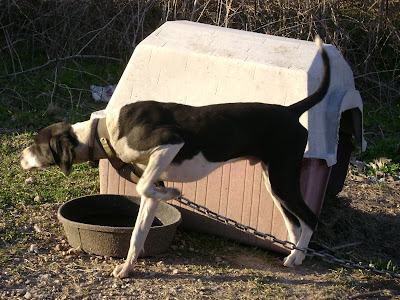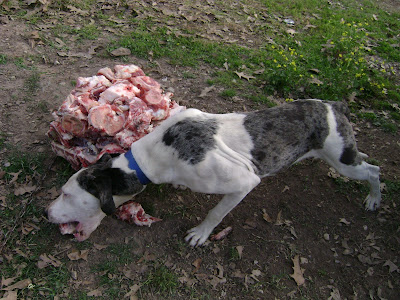Below is an article I have copied and pasted here for your convience.
I got it from the site link below.
http://www.hillockkennels.com/Hunter_mistakes.htmlI pasted the link in a previous post and I couldn't get it to work.
I believe the author is Ken Cooper.
Common mistakes hunters make before calling in a tracking dog and misconceptions.
These are things that I have run into over the last few years.
This is not an all inclusive list of mistakes as I am sure I will
continue to see new things the more I track for other hunters.
Mistake No. 1: Walking down the middle of the blood trail.
Then when hunters get to where the blood runs out,
they start walking all over the place.
This transfers blood from their boots to places the deer did not go.
When the dog gets there to track and gets to this point on the trail they have to
spend a lot of time unraveling this false blood trail that is now laid out.
Be careful and walk to the side of the trail where possibly,
avoiding any contact with the blood.
Mistake No 2:
Not visually or physically marking where the deer was standing when they shot.
This point can be very important to a tracker in that a lot of information
can be gained by looking at the color of hair at the hit site
along with any bone that might be there.
Mistake No. 3:
Hunters who do not know who their neighbors are,
nor how to contact them in case the deer travels across property lines.
In Georgia it is illegal to cross property lines without permission even to track a wounded deer.
A solution is to go ahead and make arrangements
with your neighbors ahead of time just in case.
This will help when late at night you come to a property line
and you are trying to find out who owns the property.
You will be very disappointed when the tracker and his dog call it quits,
so get permission ahead of time.
Mistake No. 4:
Not being prepared for an after-dark tracking job.
A pen light works fine for walking into the woods,
but when you need to see the most minute sign you need a very bright light.
Bring several good lights just in case your batteries die or a bulb blows.
Mistake No. 5:
Not marking the blood trail.
Marking the blood trail helps the tracker to see that their dog
is following the right blood trail to the point of loss.
If the blood trail is very light the handler may not see any blood as they will be watching their dogs reaction.
By marking the
last spot of blood the handler will know that at that point there might be a lot of false trails; see Mistake No. 1.
Mistake No. 6:
Pushing the deer.
If the deer travels out of site after the shot, give it 30 to 45 minutes before you come down to look at the hit site.
As soon as you start tracking and see that the animal may travel a great distance, or blood color reveals a poor shot,
back out and give it at least four hours if the temperature will allow and you are not worried about coyotes.
If there is signs of
a gut shot wait six to eight hours before tracking again.
Most mortally wounded deer will try to lay down within 200 to 300 yards,
but if they’re pushed out of the bed they can travel great distance before expiring.
A few misconceptions about tracking dogs
"It has been raining so a dog will not be useful."
Actually a light rain helps to hold the scent. Some dogs are even able to
track after heavy rains.
It is always better to call as soon as possible but if you can not get a tracking dog until it 12 hrs or more then do not worry.
A lot of people think that a dog is only good if the track is under a few hours old. Actually a well trained dog will be able to follow a scent trail 20 even 40 hrs old, even if other deer or wildlife have traveled the same trail.
The meat may not be any good if the weather is hot or the yotes might have gotten to it,
but if you want to recover your trophy do not be afraid to call in a quality tracking dog.
Another misconception is that "a tracking dog will always find your animal".
A tracking dog greatly increases your
chances of finding a wounded animal but it is by no means a guarantee.
Dogs have bad days just like people do.
Also many deer survive what hunters think to be a kill shot.
Hillock Kennels
Williamson Ga 30292
770-468-5459
Contact
Ken Parker










